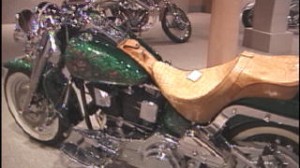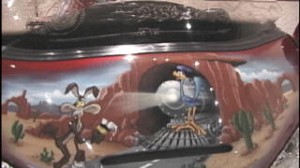A brush with bikes
The art of speed on display at DeLand Museum of Art
From OrlandoCityBeat.com, March 1, 2004
Matisse, Monet and motorcycles are not three words you often hear in the same sentence. But that doesn’t stop Chris Cruz, “Florida’s airbrush wizard,” according to Low Rider Magazine, from elevating Bike Week to a new cultural plateau.
 “The Art of Chrome and Leather,” Cruz’s exhibition at the Deland Museum of Art, features 11 custom-painted motorcycles, 10 photos of his other bike art and several unique installations featuring gas tanks, fenders, and windshields. For bike lovers, this is a must-see, a stylish, detailed and whimsical presentation of Harley high culture.
“The Art of Chrome and Leather,” Cruz’s exhibition at the Deland Museum of Art, features 11 custom-painted motorcycles, 10 photos of his other bike art and several unique installations featuring gas tanks, fenders, and windshields. For bike lovers, this is a must-see, a stylish, detailed and whimsical presentation of Harley high culture.
Non-bikers will appreciate the talent and originality behind the art and may even gain a respect for the elongated elegance of the vehicles. However, they will also be left asking why Cruz chose bikes as his canvas, because his artistic vision rarely rises to the next level, one where the bike’s form truly merges with the paintings. Missing from the exhibit is this marriage of utilitarianism and surrealism, a sort of Dadaist statement that motorcycle art can be about more than just motorcycles.
 The strongest pieces are the ones that most successfully blend the images airbrushed onto the bikes and the bikes themselves. Animal forms, captured passionately in two adapted Harleys called “White Tiger” and “Leopard,” bring to anthropomorphic life the motorcycles while capturing the sense of speed, freedom and power that fuels the American bike culture.
The strongest pieces are the ones that most successfully blend the images airbrushed onto the bikes and the bikes themselves. Animal forms, captured passionately in two adapted Harleys called “White Tiger” and “Leopard,” bring to anthropomorphic life the motorcycles while capturing the sense of speed, freedom and power that fuels the American bike culture.
Another exceptional work is “Evolution of the Dinosaur,” featuring an extended rake that complements the subject by giving the whole bike a sleek, yet thin and bony look reminiscent of the lean aquatic dinosaurs pictured on the machine. Cruz also makes excellent use of color and space as the higher parts of the bike are reserved for the land dinosaurs with the lower sections transformed into brilliant blues and greens of prehistoric seas.
“The Wild West” has an untamed, free quality, fitting for both the wild Mustangs painted on it and the spirit of the open road. Also capturing some of this rebellious quality but in a much more bad-boy way, is another Harley festooned with flames, skulls and the words “see you in hell” scrawled under the odometer. A softer side of nature and even mythology pop up in Cruz’s work too, most noticeably in the animal-laden “Florida Bike” and the “Leprechaun Bike,” the classiest of the machines.
Despite offering Cruz more surface space on which to paint, the two Hondas, with their large boxy shapes, lack the graceful forms of the Harleys and therefore do not capture the energy of the other works. The images Cruz has chosen for these two also seem more suited to a canvas than a bike.
James Murphy, visiting professor at Stetson University, frames the exhibit with an essay relating Cruz’s work to Italian Futurism, the primacy of speed and the dynamism of modern technology. For the comparison to be apt, though, Cruz must challenge our notion of what a fuel tank, a fender and a front fork can be. He clearly has the talent and the flair to grow from painting animals and landscapes on a machine to bringing the machine itself into a new artistic realm.
© 2004 Orlando Sentinel / Tribune Publishing / MeierMovies, LLC